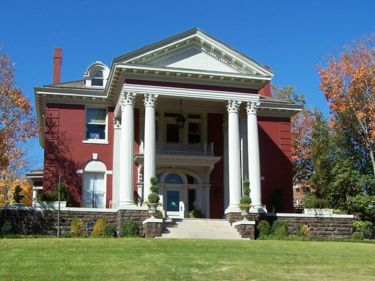A. B. Loveman residence: Difference between revisions
(New page: right|375px|thumb|A. B. Loveman residence, November 2011 The '''A. B. Loveman residence''' is an early 20th-century Neoclassical home at 2956 [[Rhodes Cir...) |
No edit summary |
||
| Line 1: | Line 1: | ||
[[Image:ABLoveman_residence.jpg|right|375px|thumb|A. B. Loveman residence, November 2011]] | [[Image:ABLoveman_residence.jpg|right|375px|thumb|A. B. Loveman residence, November 2011]] | ||
The '''A. B. Loveman residence''' is an early 20th-century Neoclassical home at 2956 [[Rhodes Circle]] in [[South Highlands]], built for retailer [[A. B. Loveman]] circa [[1908]]. The building now | The '''A. B. Loveman residence''' is an early 20th-century Neoclassical home at 2956 [[Rhodes Circle]] in [[South Highlands]], built for retailer [[A. B. Loveman]] circa [[1908]]. The 2-story, 5,744-square-foot building now serves as the offices of [[Candace B. Peeples Family Law]]. | ||
The simple block of the house is made monumental by the richly detailed and pedimented portico with its clustered Corinthian columns and detail moldings. Although the identity of the architect is obscure, it is attributed to the firm of [[Wheelock, Joy, and Wheelock]]. It is thought to have been at least partially designed by [[Thomas Walter III]], grandson of U.S. Capitol architect Thomas Ustick Walter. | The simple block of the house is made monumental by the richly detailed and pedimented portico with its clustered Corinthian columns and detail moldings. Although the identity of the architect is obscure, it is attributed to the firm of [[Wheelock, Joy, and Wheelock]]. It is thought to have been at least partially designed by [[Thomas Walter III]], grandson of U.S. Capitol architect Thomas Ustick Walter. | ||
The house | The house remained in the Loveman family for two generations. The former carriage house at the rear of the property had been a secondary residence for the family of [[A. G. Gaston]], a pioneering African-American businessman, whose mother worked as a cook for the Loveman family. | ||
[[Leona Loveman Cronhelm]] sold the house in [[1973]] to a religious group. Shortly thereafter, the [[Salvation Army]] purchased it as a home for girls who used some of the rooms as a bowling alley. | |||
The house was included as a part of the [[Highland Avenue|Highland Avenue-Rhodes Park Historic District]] in the [[National Register of Historic Places]] in [[1977]] and expanded in [[1982]]. | The house was included as a part of the [[Highland Avenue|Highland Avenue-Rhodes Park Historic District]] in the [[National Register of Historic Places]] in [[1977]] and expanded in [[1982]]. | ||
Back on the market in the early 1980s, attorney [[David Shelby]] purchased it for himself and his law partner [[Robert Roden]] for use as the offices of their [[Shelby Roden]] law partnership. Shelby restored the house, retaining original materials and features, creating minimal changes to the interior arrangements and completely refurbishing the exterior. | |||
In [[2008]] Roden purchased the house and again refurbished the office as well as the carriage house. He sold it in December [[2014]] to [[Candace Peeeples]] for $750,000. | |||
==References== | ==References== | ||
* Seligman, Scott D. (2009) "[http://www.liebman-loveman.com/Loveman%20Merchants1.htm Loveman Merchants - Birmingham]". Liebman-Loveman.com | * Seligman, Scott D. (2009) "[http://www.liebman-loveman.com/Loveman%20Merchants1.htm Loveman Merchants - Birmingham]". Liebman-Loveman.com | ||
* Hummerstation (November 14, 2011) "A.B. Loveman House - Birmingham, AL." Waymarking.com | * Hummerstation (November 14, 2011) "A.B. Loveman House - Birmingham, AL." Waymarking.com | ||
* Davis, Bryan (December 16, 2014) "Historic A.B. Loverman Residence acquired by attorney." {{BBJ}} | |||
[[Category:1908 buildings]] | [[Category:1908 buildings]] | ||
Revision as of 13:24, 16 December 2014
The A. B. Loveman residence is an early 20th-century Neoclassical home at 2956 Rhodes Circle in South Highlands, built for retailer A. B. Loveman circa 1908. The 2-story, 5,744-square-foot building now serves as the offices of Candace B. Peeples Family Law.
The simple block of the house is made monumental by the richly detailed and pedimented portico with its clustered Corinthian columns and detail moldings. Although the identity of the architect is obscure, it is attributed to the firm of Wheelock, Joy, and Wheelock. It is thought to have been at least partially designed by Thomas Walter III, grandson of U.S. Capitol architect Thomas Ustick Walter.
The house remained in the Loveman family for two generations. The former carriage house at the rear of the property had been a secondary residence for the family of A. G. Gaston, a pioneering African-American businessman, whose mother worked as a cook for the Loveman family.
Leona Loveman Cronhelm sold the house in 1973 to a religious group. Shortly thereafter, the Salvation Army purchased it as a home for girls who used some of the rooms as a bowling alley.
The house was included as a part of the Highland Avenue-Rhodes Park Historic District in the National Register of Historic Places in 1977 and expanded in 1982.
Back on the market in the early 1980s, attorney David Shelby purchased it for himself and his law partner Robert Roden for use as the offices of their Shelby Roden law partnership. Shelby restored the house, retaining original materials and features, creating minimal changes to the interior arrangements and completely refurbishing the exterior.
In 2008 Roden purchased the house and again refurbished the office as well as the carriage house. He sold it in December 2014 to Candace Peeeples for $750,000.
References
- Seligman, Scott D. (2009) "Loveman Merchants - Birmingham". Liebman-Loveman.com
- Hummerstation (November 14, 2011) "A.B. Loveman House - Birmingham, AL." Waymarking.com
- Davis, Bryan (December 16, 2014) "Historic A.B. Loverman Residence acquired by attorney." Birmingham Business Journal
